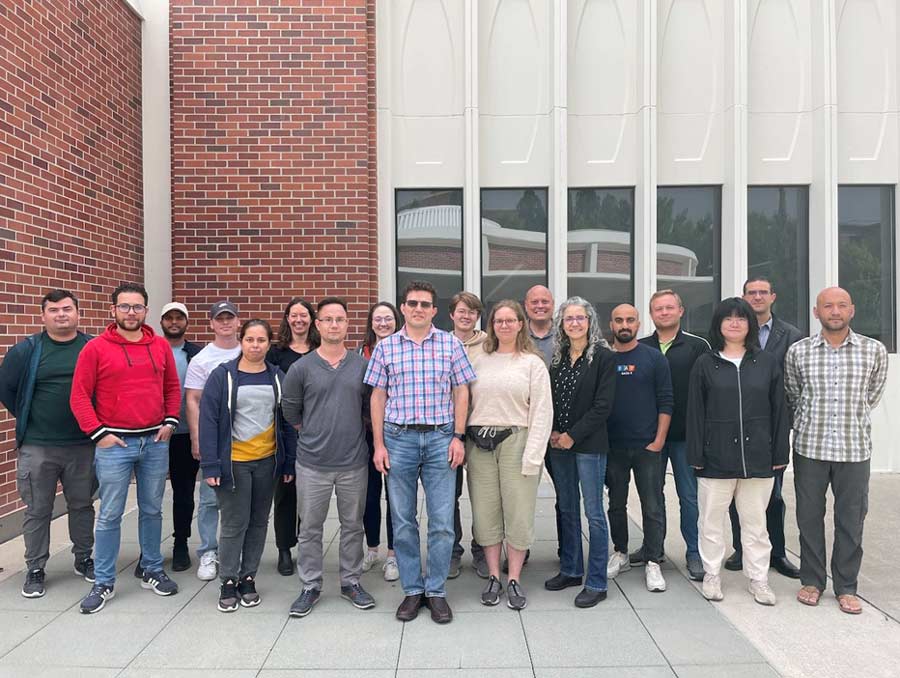Earlier this year, Sergey Varganov, professor of chemistry, and his colleagues received a $3.2 million funding renewal on a Department of Energy (DOE) grant they received two years ago. Varganov and his colleagues received the renewal for a DOE Established Program to Stimulate Competitive Research (EPSCoR) grant to fund the development of a quantum research group at the University. The funding renewal will provide two additional years of funding to the project and comes after a progress-filled successful two years for the researchers.
The grant’s research team is comprised of Department of Chemistry professors Varganov and Ana de Bettencourt-Dias and associate professors Natia Frank and Matthew Tucker, Department of Physics Assistant Professor Yafis Barlas, and Department of Chemical and Materials Engineering Associate Professor David Cantu. An additional collaborator, Yuri Alexeev at Argonne National Laboratory (ANL), has supported the project as well.
The researchers are developing design guidelines for molecules that can be used in high-density memory, quantum sensing and quantum computing. Varganov believes there is near-term potential for practical quantum devices, like a magnetic hard drive that can be used to store a massive amount of either classical or quantum information. The researchers’ current focus is developing small, single-molecule magnets that can be organized into arrays to maximize the memory density of such a hypothetical hard drive. The single-molecule magnets can act as quantum bits, or “qubits,” which store information. When an operation is run on the computer, the qubits are forced to interact to accomplish a given computational task. The information can be corrupted due to what scientists call “noise” originating from the interaction of qubits with their surrounding environment, so the researchers are studying various molecules at different temperatures and different environments to determine which molecules are most resistant to corruption.
Over the past two years, the team has published eight research papers based on work supported by the grant. Faculty, students and postdoctoral scholars have attended national and international conferences, including the American Physics Society, and presented eleven talks and six posters. One student participated in an internship at ANL, and one postdoctoral scholar visited and conducted research at Pacific Northwest National Laboratory. The group was also able to purchase new equipment, including high-performance computer nodes and hardware for spectroscopy.
Varganov outlined the two major goals of the grant and its renewal: advancing the science by developing guidelines for building molecular magnets and qubits for quantum applications and building the quantum workforce in the state and for the national labs by educating students about quantum information science (QIS).
In fall 2022, faculty members in the research group each taught part of a graduate level class on QIS. The class, which attracted graduate students from a variety of disciplines including chemistry, physics and computer science, was very popular. Due to limited resources, faculty couldn’t teach the class in fall 2023, but they will be teaching it again in fall 2024. They plan to offer the class to both graduate and undergraduate students in 2024.
“I think that one of the strongest parts of this grant is that we're also trying to build some serious educational components,” Varganov said.
Vaganov hopes to eventually offer an undergraduate minor in QIS.
EPSCoR targets 30 U.S. states and territories with funding to strengthen their scientific and engineering capacities. Nevada is one of the states targeted for EPSCoR funding, and Varganov hopes that this project will advance QIS research in Nevada.
“Hopefully we'll facilitate University interest in establishing a center for quantum science and engineering by leveraging the expertise we already have on campus,” Varganov said.
Varganov would like to involve more faculty from physics, chemistry and chemical and materials engineering, and from other disciplines not currently represented in the group, like computer science. Alexeev at ANL is an expert in the development of quantum algorithms but cannot be paid due to the grant requirements and because of this can only offer so much of his time on the project. Varganov hopes the project can become much more interdisciplinary in the coming years.
In the next year, the researchers plan to establish an advisory board, including a member from the industry, to guide the research group’s efforts.
“I think that's the first step towards real collaboration with industry, where maybe somebody will be really interested in making devices based on molecules, is to demonstrate that molecular systems can be scaled to multi-qubit arrays resilient to environmental noise,” Varganov said.















